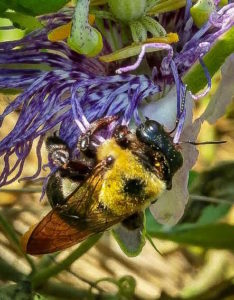Volume 22 Issue 3, Fall 2017
by Anne Owen, Audubon at Home Ambassador
Mention planting vines for their value to wildlife and the most common reaction is that they are too messy, too big and too aggressive for a small, or even an average yard. This is a shame and very likely comes from bad experiences with those pesky non-natives, so loved by Garden Centers, which certainly can grow out of control.
Our native vines, while vigorous, are generally less aggressive and provide nectar, berries and host services for a wide variety of birds, butterflies and bees. In a small yard, they can be grown in pots to help contain roots and runners. Vines can be trained on a wall, or on a trellis that provides a wildlife habitat that can also be structured as a privacy barrier. Vines can be trimmed back at the end of the growing season, or the tips pinched to encourage a bushy habit. By growing upward rather than outward, they can provide a lot of habitat for only a small amount of real estate…what’s not to like?
The humble Virginia Creeper, Parthenocissus quinquefolia, is among a wildlife gardener’s most versatile plants. It can be used as a climber or as ground cover and provides brilliant Fall color. It is the larval host for several species of Sphinx Moth and its berries are valuable winter food for many of our over-wintering birds, including chickadee, nuthatch and woodpeckers. Virginia Creeper is easy to pull and the little adhesive pads that it uses instead of penetrating rootlets do little damage, so it is easy to control, even in a small space.
Pipevine, Aristolochia macrophylla, is native to the southern Appalachian hardwood forest, and has been naturalized further north into Virginia. It has attractive, large, heart-shaped leaves and a unique, pipe-shaped flower. It is attractive to butterflies and is the larval host of the Pipevine Swallowtail.
Fans of Passionflower, Passiflora , have two species to consider. Both species provide nectar for butterflies and other insects and both produce fruit that is beneficial to birds and small mammals. Both also host a number of caterpillar species. Maypop, P. incarnata, is the larger and showier of the two, with very intricate, 3-inch, lavender flowers. It hosts the Variegated Fritillary caterpillar, Euptoieta claudia. Yellow Passionvine, P. lutea, is smaller, with greenish-yellow flowers, only about 1 inch across, with purple or black berries. This Loudoun native also has a long flowering period from May to September. Both Passionflowers can spread quickly, so are best grown in a container to keep them in check. Violets (Viola sp.) can be added to the pot as an additional Spring-flowering Fritillary host.
Our Native Coral Honeysuckle, Lonicera sempervirens, must not be confused with the pale flowers and invasive habits of the introduced Japanese and European species that have little or no wildlife value. Native L. sempervirens produces clusters of red, tubular blooms from March to June, providing a welcome early nectar source for Hummingbirds and butterflies. The bright red berries attract Purple Finch, Goldfinch, Hermit Thrush and American Robin. It is semi-evergreen to provide some visual winter interest.
A final gem to consider is American Wisteria, Wisteria frutescens. This North American native has become naturalized in our region and is less aggressive and less damaging than the popular, introduced Asian species. It produces lovely, fragrant dropping flower clusters in May to June, attracting butterflies and acting as a larval host to several species of skipper.
So, who can find a spot for one of these glorious native vines?
If you are interested in learning more about how you can provide habitat for wildlife on your own property and about the Audubon at Home Program, please contact Ann Garvey at agarvey@loudounwildlife.org for more information.




